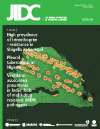Antibiotic resistance patterns of bacterial strains isolated from Periplaneta americana and Musca domestica in Tangier, Morocco
DOI:
https://doi.org/10.3855/jidc.336Keywords:
Periplaneta americana, Musca domestica, bacteria, antimicrobial resistanceAbstract
Background: Flies and cockroaches are two insects in close contact with human beings. They are carriers of human pathogenic bacteria on the external areas of their bodies or in their digestive tracts. This study examines Periplaneta americana and Musca domestica collected from the residential areas of six districts in Tangier, Morocco.
Methodology: In total, 251 bacteria were isolated from external areas of the participants' bodies and the antimicrobial susceptibility was calculated.
Results: The predominant bacterial species included Escherichia coli (17.9%), Klebsiella spp. (14.7%), Providencia spp. (9.6%), Staphylococcus spp. (15.1%) and Enterococcus spp. (11.6%). The study showed no difference between the species of bacterial strains from American cockroaches and houseflies. Carbapenems and aminoglycosides were active against 100% of the Gram-negative bacilli isolated in this study. Staphylococcus spp. strains were susceptible to linezolid, vancomycin, daptomycin, levofloxacin and cotrimoxazole, and no antibiotic resistance was found in Enterococcus spp.
Conclusions: In our setting, although both cockroaches and flies collected from residential areas may be vectors of human pathogenic bacteria, the infections caused by them are easily treatable as a result of the high susceptibility of their bacteria to antibiotics routinely used in the community or in hospitals.
Downloads
Published
How to Cite
Issue
Section
License
Authors who publish with this journal agree to the following terms:
- Authors retain copyright and grant the journal right of first publication with the work simultaneously licensed under a Creative Commons Attribution License that allows others to share the work with an acknowledgement of the work's authorship and initial publication in this journal.
- Authors are able to enter into separate, additional contractual arrangements for the non-exclusive distribution of the journal's published version of the work (e.g., post it to an institutional repository or publish it in a book), with an acknowledgement of its initial publication in this journal.
- Authors are permitted and encouraged to post their work online (e.g., in institutional repositories or on their website) prior to and during the submission process, as it can lead to productive exchanges, as well as earlier and greater citation of published work (See The Effect of Open Access).








